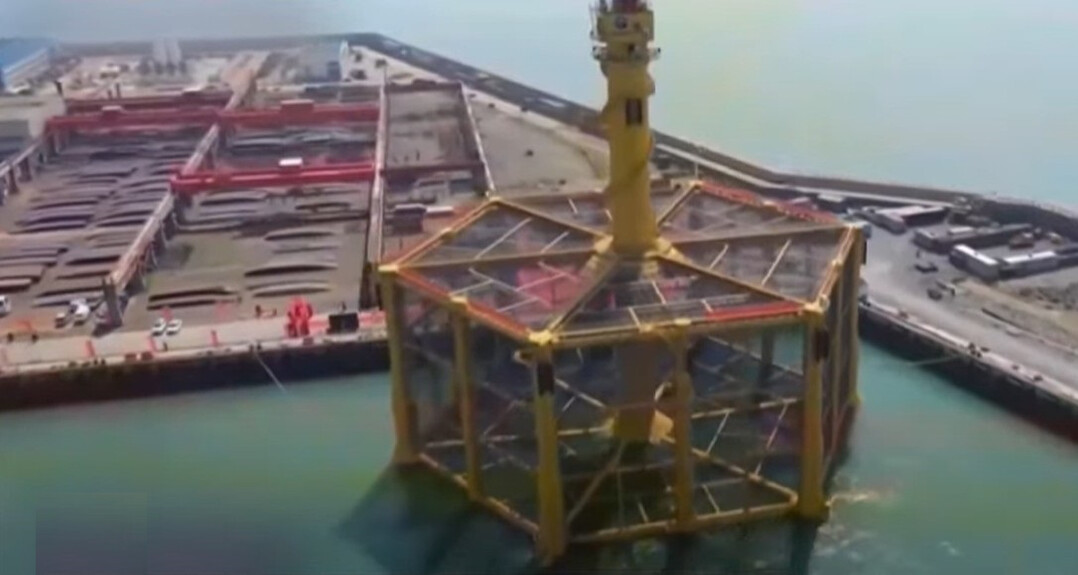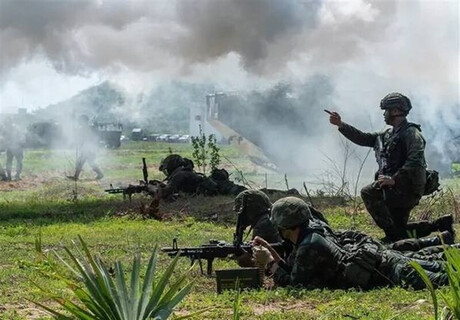
SEOUL, South Korea – Concerns are mounting in South Korea over China's escalating activities in the West Sea (also known as the West Sea), where a series of mysterious structures have been spotted within the Provisional Measures Zone (PMZ), a disputed area jointly managed by both nations. While Beijing insists these are merely "fishery management support facilities," Seoul views their construction as a potential threat to its maritime sovereignty and national security.
Photos taken by the Korea Institute of Ocean Science and Technology (KIOST)'s research vessel R/V Onnuri show what China claims to be aquaculture facilities. However, the scale and nature of these installations, including the "Xianlan 1 and 2" steel structures, some reportedly 70 meters high, along with drilling facilities equipped with helicopter pads and 13 surrounding buoys, have raised red flags in Seoul. These developments, which began around 2018, are leading many experts to warn that China is employing a "gray zone strategy" to transform the Yellow Sea into its "internal sea," reminiscent of its assertive actions in the South China Sea.
Echoes of the South China Sea: A "Gray Zone" Strategy
The PMZ is an area where the Exclusive Economic Zones (EEZs) of South Korea and China overlap. Established under a 2000 fisheries agreement, the zone was intended for joint management. However, China's recent actions, including the establishment of fixed structures and even military exercises involving aircraft carriers within designated navigation exclusion zones, have fueled fears that Beijing intends to replicate its South China Sea playbook.
The "gray zone strategy" refers to a tactic where a nation gradually achieves its strategic objectives through incremental actions and policy ambiguity, without overtly resorting to military force. China has a notorious track record of employing this strategy in the South China Sea, where it has constructed artificial islands in disputed territories with the Philippines and Taiwan, subsequently deploying anti-aircraft guns and missiles, and claiming the islands and surrounding waters as its own sovereign territory.
Experts believe China is applying this phased approach to the Yellow Sea. The concern is that Beijing might expand these large structures and eventually deploy military equipment and naval forces, ultimately asserting territorial claims. This strategy also serves a broader geopolitical purpose: to deter the U.S. military in the event of a U.S.-China conflict. Strategic bases in the Yellow Sea could hinder the U.S. Navy's access to Beijing and coastal cities and act as a deterrent against U.S. Forces Korea stationed on the Korean Peninsula.
Ban Kil-joo, a professor at the Korea National Diplomatic Academy, emphasized this parallel, stating, "China's strategy to internalize the South China Sea has been a long-term process spanning 70 years, now entering an advanced stage involving naval power. We must note that this same phased gray zone strategy is being directly applied to the attempt to internalize the Yellow Sea."
Diplomatic Pressure, Proportional Response, and Potential Confrontation
South Korea faces a complex challenge. The structures are located outside the mid-line of the PMZ, making direct legal action difficult under UN conventions that limit a nation's jurisdiction in unconfirmed boundary zones to its own citizens and fishing vessels. Consequently, experts advocate for initial diplomatic measures, such as addressing China's violations through the Korea-China Fisheries Joint Committee or Korea-China Maritime Cooperation Meetings.
Jung Min-jung, a legislative researcher at the National Assembly Research Service, suggested, "Rather than unilateral legislative measures to regulate Chinese structures, it is desirable to resolve the issue through diplomatic coordination. If China's structures are used for military purposes like surveillance, reconnaissance, or disrupting navigation, international cooperation, including security consultations with the U.S. and Japan, may be necessary to pressure China."
Another proposed strategy is a "proportional response," where South Korea installs similar maritime structures in the mid-line areas of the PMZ. Just as international law doesn't explicitly prohibit China's facilities, there's no legal basis for China to prohibit South Korea's. Options include establishing marine science research bases for oceanographic, meteorological, and environmental observations, large observation buoys, or even floating power generation facilities.
Furthermore, some argue for proactive military countermeasures before the structures become militarized. This includes regularizing intelligence gathering in the Yellow Sea PMZ using ISR (Intelligence, Surveillance, and Reconnaissance) assets like reconnaissance satellites, maritime patrol aircraft, and drones. Strengthening surveillance and on-site response capabilities through joint patrols by the Navy and Coast Guard is also recommended. Crucially, sharing intelligence with the U.S. and conducting joint maritime exercises could elevate the issue beyond a bilateral Korea-China concern to an aspect of the broader U.S.-China strategic competition.
More assertive methods, akin to the Philippines' tactics in the South China Sea, have also been discussed. In 1997, to counter China's provocations in the South China Sea, the Philippines intentionally grounded a World War II-era landing ship on the Second Thomas Shoal. Since then, it has maintained a small contingent of troops on board, effectively using the vessel as a defensive outpost to assert its territorial claims.
Kim Dong-gyu, editor-in-chief of the international affairs magazine PADO, suggested, "We could also use a method of crashing abandoned oil tankers or merchant ships into Chinese structures, disguised as accidental collisions. Simultaneously, we need to send a strong signal that we can also build similar structures within the PMZ and use them as military facilities in case of emergency, just like China."
The growing Chinese footprint in the Yellow Sea presents a significant and evolving challenge for South Korea, demanding a comprehensive and multi-faceted response across diplomatic, legal, and potentially military dimensions.
[Copyright (c) Global Economic Times. All Rights Reserved.]






























